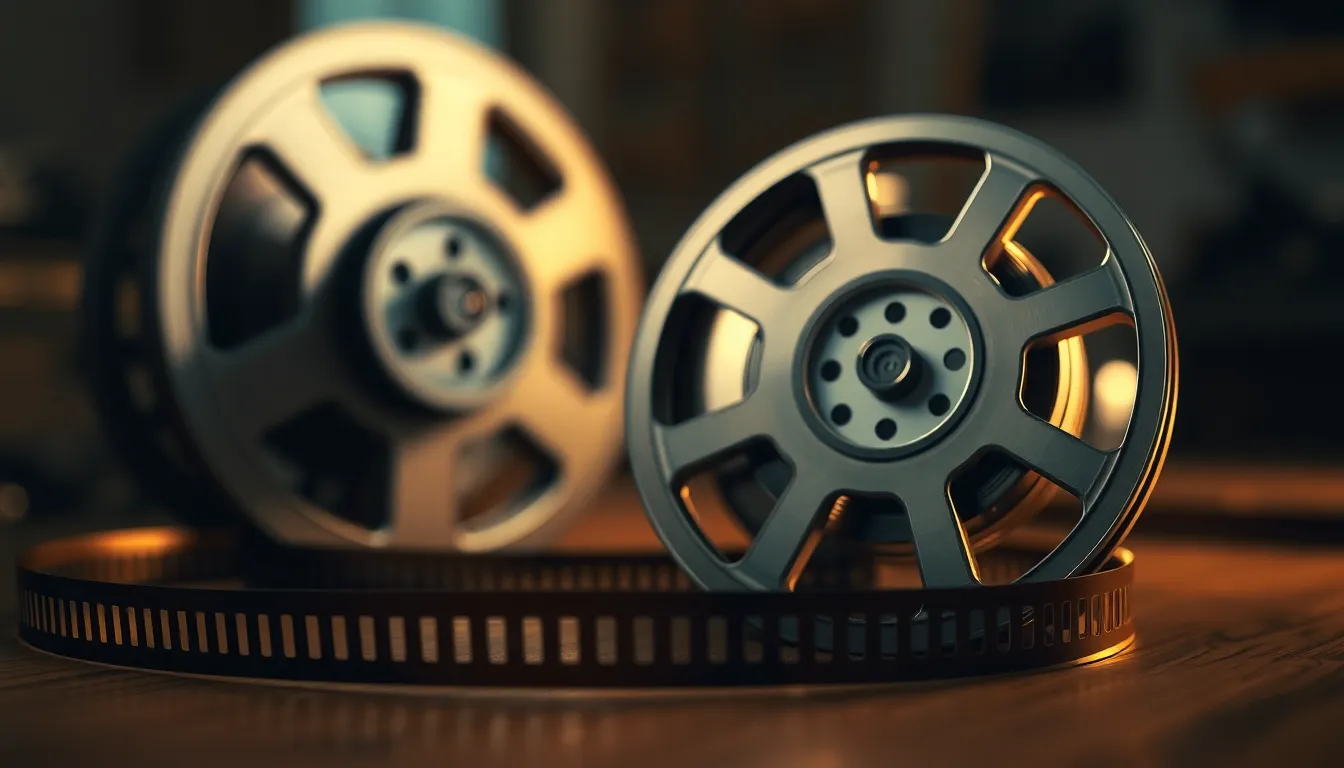Table of Contents
ToggleFilm theory isn’t just for pretentious college students with berets and a penchant for espresso. It’s the secret sauce that transforms a casual movie night into a mind-bending exploration of art, culture, and the human experience. Ever wondered why that romantic scene made your heart flutter or why the villain gave you chills? Film theory dives deep into these questions, revealing the hidden mechanics behind cinematic magic.
Overview of Film Theory
Film theory explores the mechanisms that shape cinematic experiences. It serves as a framework for understanding the various elements of film, including narrative structures, visual aesthetics, and audience reception. By analyzing these components, scholars and enthusiasts gain insight into how films convey themes and emotions.
Essential concepts within film theory include semiotics, the study of signs and symbols in film. Semiotics examines how visual and audio elements communicate messages to viewers. Another crucial area is genre theory, which categorizes films based on thematic and stylistic characteristics. Understanding genres allows audiences to set expectations for storylines and character arcs.
Cinematic realism represents another significant aspect of film theory. It investigates how films reflect reality or exaggerate it for artistic effect. Filmmakers apply various techniques to create a sense of authenticity or to manipulate perceptions. Audience interpretation of realism often varies based on individual experiences.
Moreover, psychoanalytic film theory delves into the psychological responses elicited by films. This approach analyzes how films tap into unconscious desires and fears. Through this lens, filmmakers craft narratives that resonate on a deeper emotional level.
Cultural studies also play a role in film theory by exploring how films represent social issues and cultural identities. This perspective emphasizes the connection between cinema and societal power dynamics. By analyzing cultural influences in film, viewers better understand the context surrounding specific narratives.
Understanding these theoretical frameworks enhances the viewing experience. It empowers audiences to engage more critically with films, transforming passive consumption into active analysis. Familiarity with film theory encourages a deeper appreciation for the art of cinema.
Key Concepts in Film Theory

Film theory encompasses various principles that enhance understanding of cinema. Recognizing these concepts enriches the movie-watching experience.
Narrative Structure
Narrative structure defines the framework through which stories unfold in films. Understanding this structure allows viewers to analyze plot development, character arcs and pacing. Three-act structure often serves as a foundational model, consisting of setup, confrontation and resolution. Furthermore, non-linear narratives present challenges and invite interpretation, leading to deeper engagement. Exploring how these elements interconnect enables audiences to appreciate storytelling techniques, ultimately shaping their viewing experience.
Cinematic Techniques
Cinematic techniques encompass the tools filmmakers use to convey meaning and emotion. Camera angles, lighting, sound and editing play crucial roles in shaping viewer perception. For instance, close-up shots often emphasize characters’ emotions while wide shots provide context. Attention to sound design enhances atmosphere and can evoke specific responses. Editing influences pacing and rhythm, guiding how audiences experience a scene. Analyzing these techniques reveals how filmmakers manipulate perception, enhancing viewers’ understanding of the filmic experience.
Genre Analysis
Genre analysis categorizes films based on thematic and stylistic characteristics. Recognizing various genres, such as horror, drama and comedy, helps viewers understand the conventions and expectations associated with each type. By examining genre conventions, audiences gain insight into storytelling devices designed to elicit specific reactions. Cross-genre films challenge assumptions and invite fresh interpretations, expanding the complexity of cinematic expressions. Thorough genre analysis enhances critical engagement, enabling a richer appreciation of the diverse landscape of cinema.
Historical Development of Film Theory
Film theory has evolved significantly over time, reflecting changes in the medium and cultural contexts surrounding cinema. Notable milestones span from early theoretical frameworks to contemporary methodologies.
Early Theories
Early film theorists laid the groundwork for understanding cinema as an art form. The 1910s saw the emergence of filmmakers and theorists like Sergei Eisenstein, who emphasized montage and its emotional impact. They explored how editing could manipulate time and perception. Additionally, André Bazin’s ideas in the 1940s focused on realism, advocating for long takes and deep focus setups, which allowed audiences to engage more authentically with narratives. These initial concepts shaped how films were created and interpreted, establishing a foundation for future critical analysis.
Contemporary Approaches
Contemporary film theory incorporates a myriad of perspectives. Scholars now examine films through lenses such as feminism, postcolonialism, and psychoanalysis. These frameworks provide insightful critiques of representation and social dynamics. The influence of technology further shapes analysis, particularly with digital media’s impact on filmmaking. Current theorists often emphasize audience interaction, investigating how viewers’ experiences are shaped by cultural context and personal identity. By integrating diverse approaches, contemporary film theory fosters a richer understanding of cinema’s role in society.
Major Film Theorists
Film theory comprises influential thinkers who shaped cinematic understanding. Their contributions offer insights into how audiences interpret and engage with films.
Sergei Eisenstein
Sergei Eisenstein stands as a monumental figure in film theory. He introduced the concept of montage, emphasizing how editing can create emotional and intellectual responses. Eisenstein believed that juxtaposing images could generate meaning beyond individual frames. His work on films like “Battleship Potemkin” illustrates how rhythmic editing enhances storytelling. Additionally, his theories extended to the psychological impact of film, focusing on how audiences connect emotionally with visual narratives. Eisenstein’s strategies in constructing cinematic sequences provide a framework for analyzing film grammar and viewer communication.
Laura Mulvey
Laura Mulvey revolutionized film theory through her essay “Visual Pleasure and Narrative Cinema.” She examined the gaze, arguing that traditional cinema often objectifies women, positioning them as passive subjects. Mulvey’s concept of the male gaze critiques the power dynamics in film narratives, influencing feminist film criticism. This perspective exposes how visual representation shapes societal views of gender. Furthermore, her analysis challenges filmmakers to reconsider narrative structures and character development. By uncovering the layers of viewer engagement, Mulvey’s work invites deeper discussions regarding representation and identity in film.
Film theory enriches the viewing experience by providing a lens through which audiences can analyze and appreciate cinema. By understanding the key concepts and historical evolution of film theory, viewers can engage more deeply with films and recognize the intricate techniques that shape narratives and emotions.
This critical approach transforms passive watching into an active exploration of themes and cultural contexts. As contemporary film theory continues to evolve, it invites diverse perspectives that further enhance the understanding of cinema’s impact on society. Embracing these insights not only fosters a greater appreciation for the art form but also encourages meaningful discussions about identity and representation in film.




